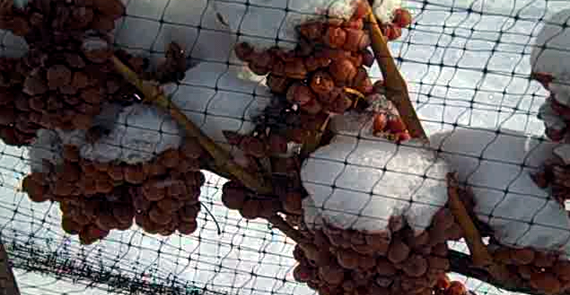
By Tom Mansell, Science Editor
I recently had the opportunity to participate in part of the ice wine grape harvest at Sheldrake Point Vineyards, located on the west side of Cayuga Lake. Ice wine grapes can and should be harvested under specific conditions. Sheldrake Point winemaker David Breeden likes to harvest between 12 and 18 degrees Fahrenheit, but it's a delicate balance.
In frozen grapes, some of the water crystallizes into ice, segregating sugars and acids into a more concentrated solution. The degree of "frozen-ness" of the grapes will determine the concentration of the syrupy solution which will be extracted from the frozen grapes in the press.
If the grapes are too warm (closer to 18F), they may start to melt and juice extracted may not be concentrated enough. If the grapes are too cold, the juice may be too concentrated. Getting this right can be difficult and time-sensitive. In spite of careful weather-watching and scheduling, harvest times are basically up in the air until the morning thereof, when phone calls ring out into the breaking dawn and crews either wait a few hours or come in a few hours early. This particular picking was scheduled for Friday, then rescheduled for Saturday at 8 a.m., then moved up to 10 a.m., then back to 8:30 a.m.
Breeden tends to shoot for Brix levels between 35 and 40 (at right is Dave checking the brix of the must on Saturday). That's about 35-40 percent sugars by weight.
At first, this might seem like a feast for yeast. Unfortunately, the concentrated sugary environment is not all that pleasant for them due to what's called osmotic stress. That is, the high dissolved solid content puts enormous pressure on the yeast cell membranes to maintain equilibrium.
Or to put it another way, it's like putting salt on a slug.
This stress leads to slow and difficult fermentations for ice wines. It also allows for some ambient microorganisms besides yeast to join the party.
Acetobacter and wine have been interacting for millenia; they're responsible for the conversion of wine into vinegar. In this case, while the yeast struggle to survive in their syrupy environment, Acetobacter and other spoilage bacteria can move in and set up shop on the surface, using ambient oxygen to turn ethanol into acetic acid (smell: vinegar), which can esterify into ethyl acetate (smell: nail polish). The combination of these two is known as volatile acidity (VA).
It turns out, though, that the biggest producers of VA in high-Brix musts are the yeast themselves. The stress caused by the high-sugar environment causes up-regulation of yeast enzymes that produce acetate. Thus, careful selection of yeast strain and tight control of fermentation conditions are important for making quality ice wine.
At Sheldrake, Breeden manages osmotic stress in his fermentations by employing a method of gradual addition of the sweet must, which maintains a Brix level between 25 and 30 throughout the fermentation. The similarities of this method to a standard semi-batch reactor with substrate inhibition kinetics just sets the chemical engineering part of my heart all aflutter.
Too much volatile acidity can render a wine unpalatable, but like many faults, small amounts of VA can add complexity to a wine. Peach and pineapple aroma characteristics, for example (hexyl acetate, ethyl butanoate) can come from esterification of acetic and other volatile acids, and descriptors like this are very common in ice wine tasting notes.
The presence of some VA, due to osmotic stress on yeast in a high sugar environment, gives the bouquet of ice wine unique characteristics that set it apart from normal table wines.
In the second part of our exploration of the science of ice wine, I'll discuss the palate and mouthfeel of ice wine and other characteristics that add to the honey-like richness that it provides.
Further Reading:
Erasmus et al., "Impact of Yeast Strain on the Production of Acetic Acid, Glycerol, and the Sensory Attributes of Icewine", American Journal of Enology and Viticulture, 2004.
